East Asian Art History
1/44
There's no tags or description
Looks like no tags are added yet.
Name | Mastery | Learn | Test | Matching | Spaced |
|---|
No study sessions yet.
45 Terms
Eastern Zhou
770 - 256 BCE
Shift in the center of the ancestral worship from ancestral shrine to tomb
Tomb is new center of ancestral worship
Zu
“Familial Lineage”
Social community is an extension of family
Mutual dependence between living and dead
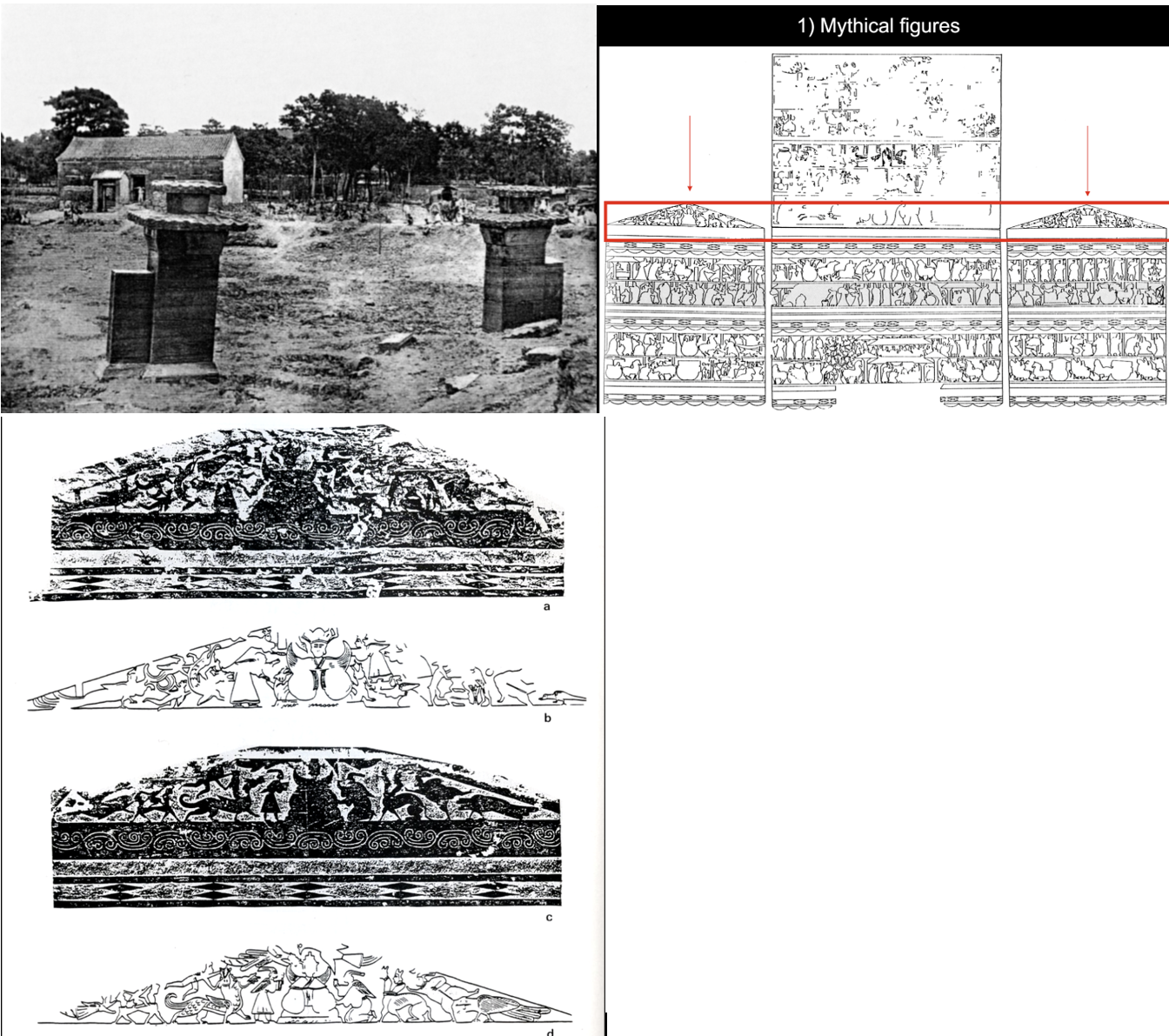
Wu Liang’s Shrine
Aristocrat who once served at the court of the Eastern Han Dynasty
Located Shandong Province ( 151 CE)
Typical Eastern Han Dynasty funerary parks - strong central axis
Pictorial reliefs installed on the shrine, form of adornment, read from top to bottom
Mythical figures: Queen Mother of West AND King Father of the East
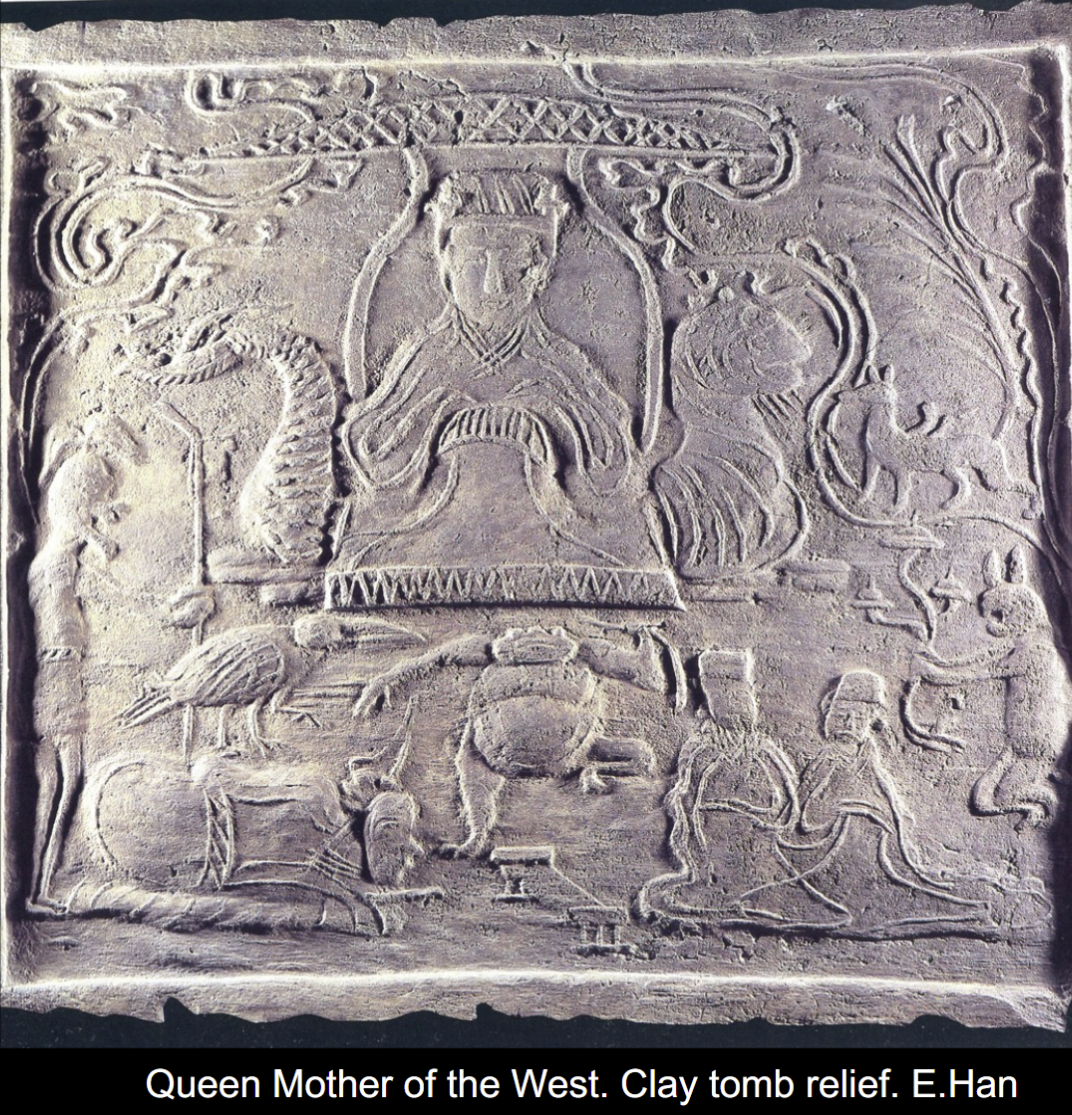
Queen Mother of the West
Idea of immortality, thought to live in Mt. Kunlun
Figures represented alongside her have a wish for the transfer to the immortal land
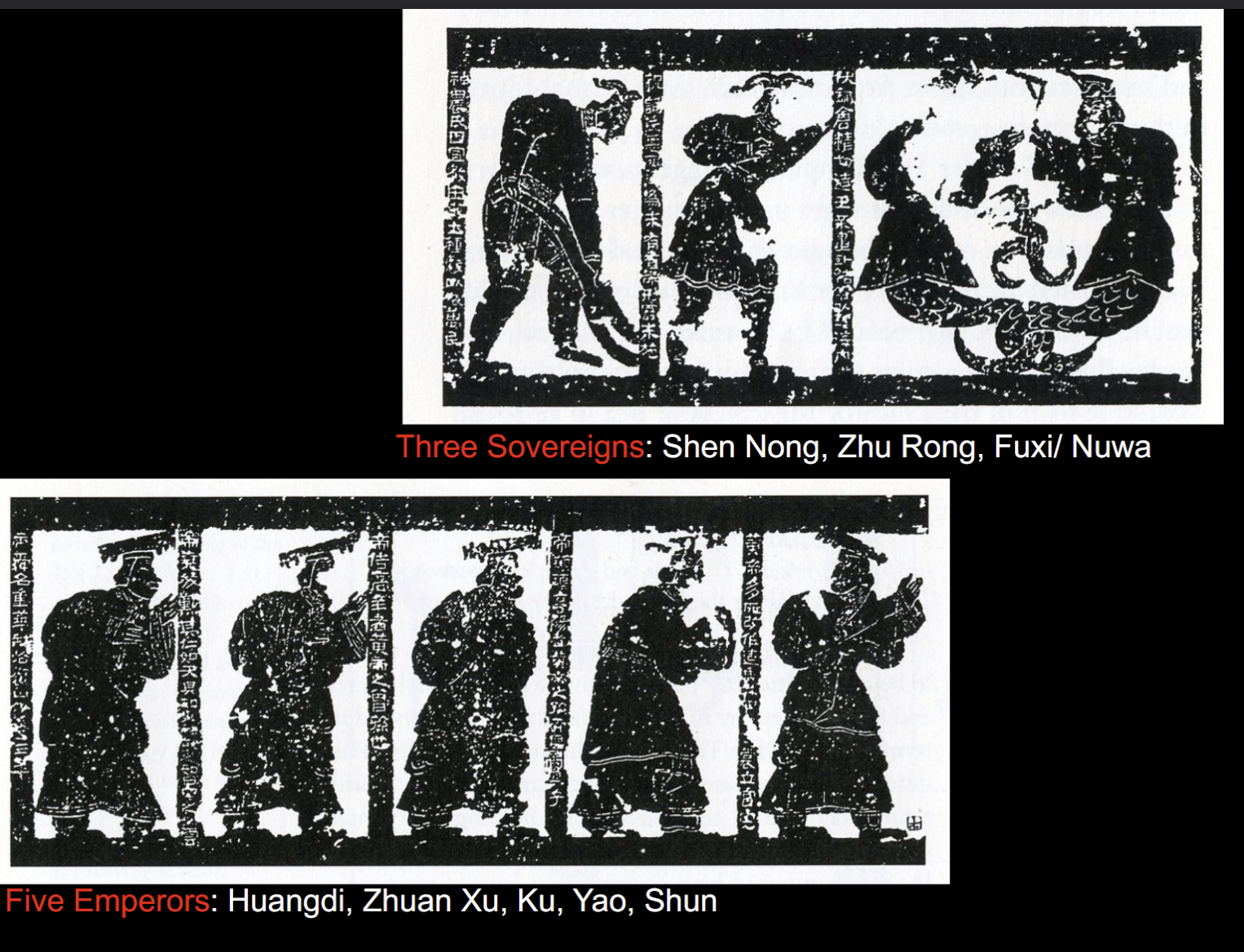
Beginning of human history depicted in Wu Liang’s Shrine under Queen Mother of East
3 Sovereigns represented as semi-deities, serpentine/ anthropomorphoc forms
Thought to have created the world (they’re holding a ruler and a spade)
5 Emperors; Human rulers the first 5
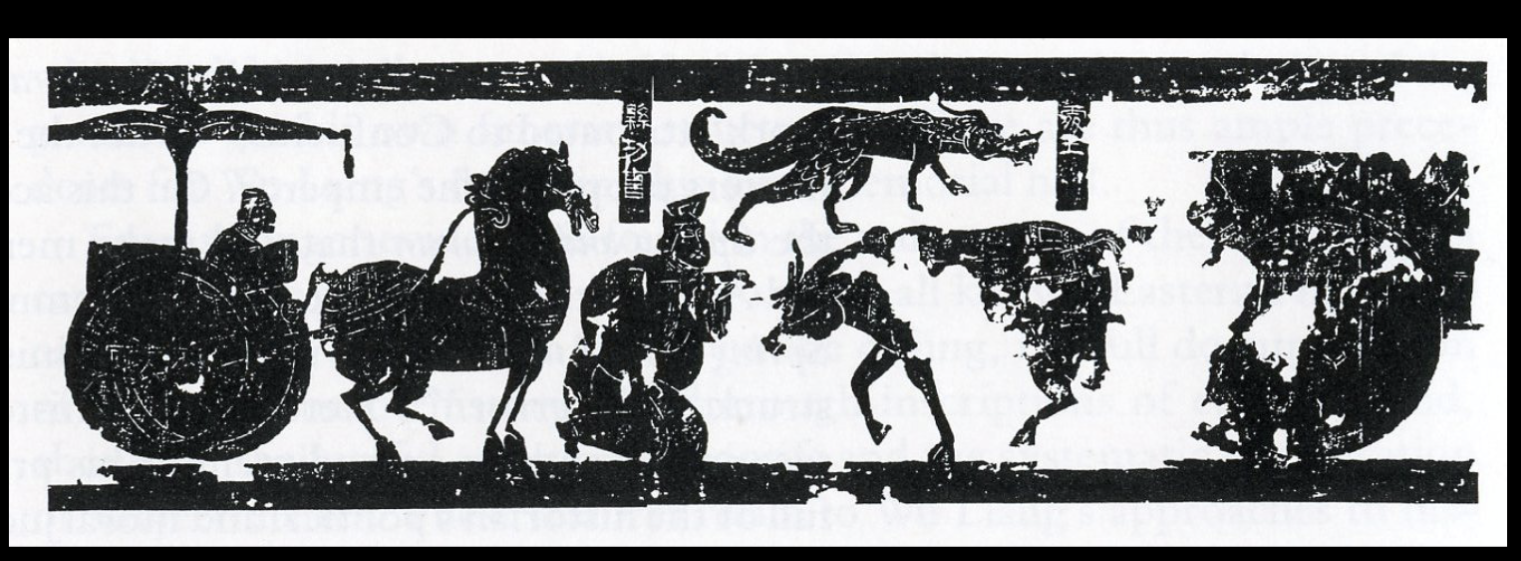
Portrait of Wu Liang
A courtly official paying homage to Wu Liang
Bigger figure is the court official
Entity floating, supposed to be ucnclear
Concept of Li
Ritually proper deportment in all social circumstances, from serious religious ceremony to trivial daily etiquette.
Most complex among 4 major family rituals; funerary rites
Provided important rules/code for making funerary art and tombs
Hun Soul vs Po Soul
Hun soul is light and goes up to the sky
Po soul is heavy and stays trapped in the ground
Visual material: Yongqi vs Mingqi
Yongqi (Practical articles) : Things used personally by the deceased and included in tombs
Mingqi (Spirit articles) : Made specially for the burial, not supposed to be used by humans (small size, etc.)
2 types of tomb structure
Vertical pit - oldest version
Horizontal chamber(s)
helps understand movement of soul
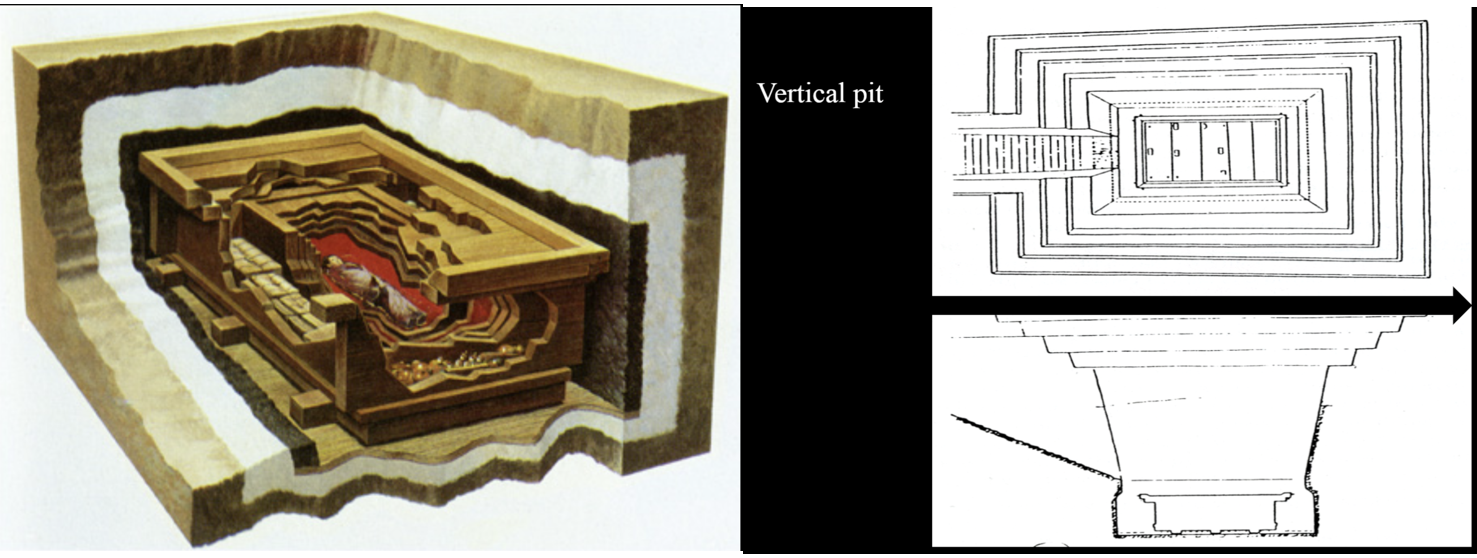
Mawangdui Tomb no.1, 2nd BCE, Hunan Province, China
Tomb of Lady Dai
Many layers of preservation and body wrapped in high quality silk → privilege and status
Feather embroidery on the second coffin of Lady Dai
Various immortals and fantastic animals painted on the outermost coffin.
Colors on lacquer woodMt.Kunlun depicted on a foot panel of one of Lady Dai’s coffins
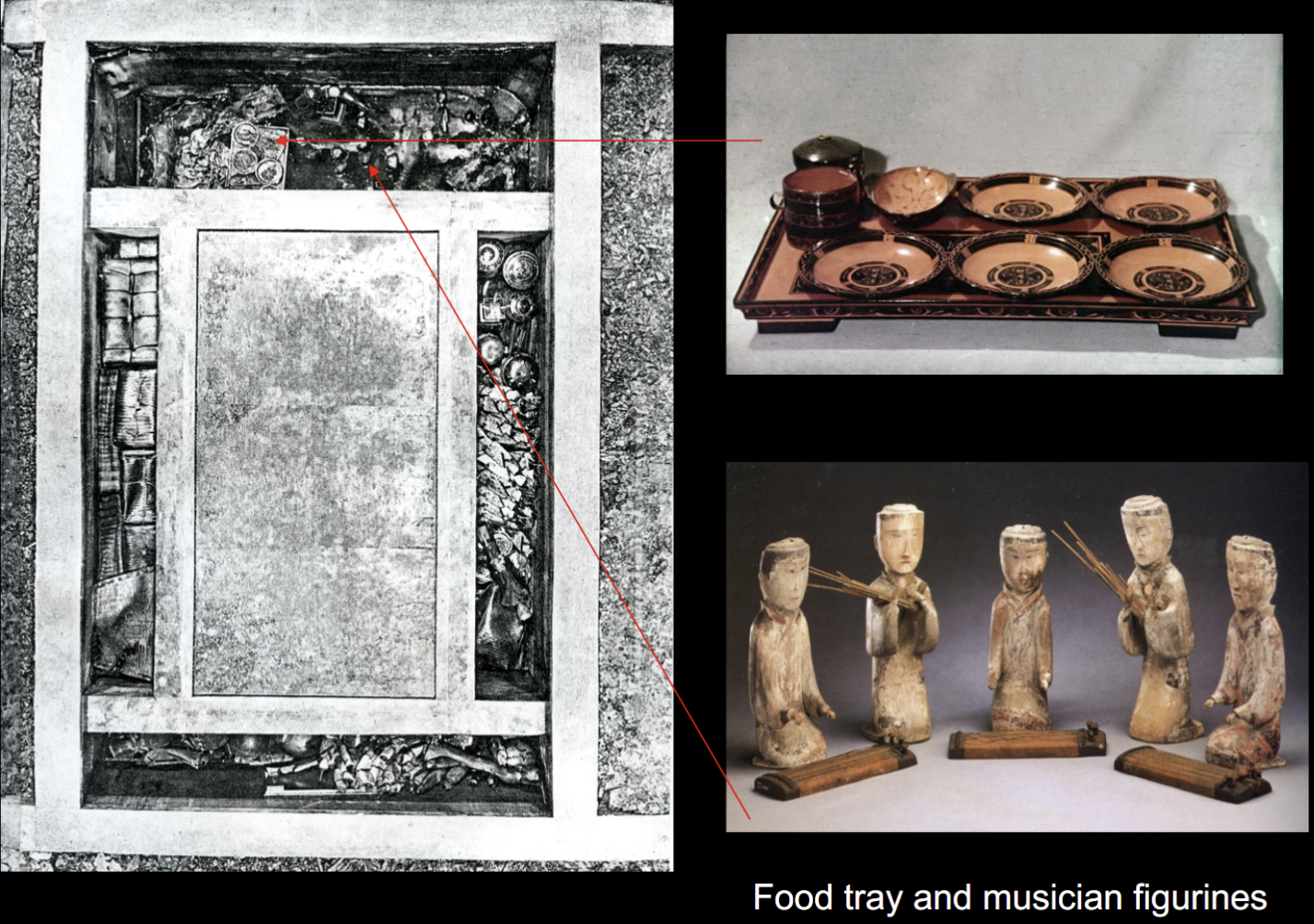
Mawangdui Tomb no.1
Food tray (with food), placed empty seat near for eating. Musican figurines play music for deceased and provide entertainment.
Minqui articles recreating like an underground household
Also contains funerary gifts offered by people
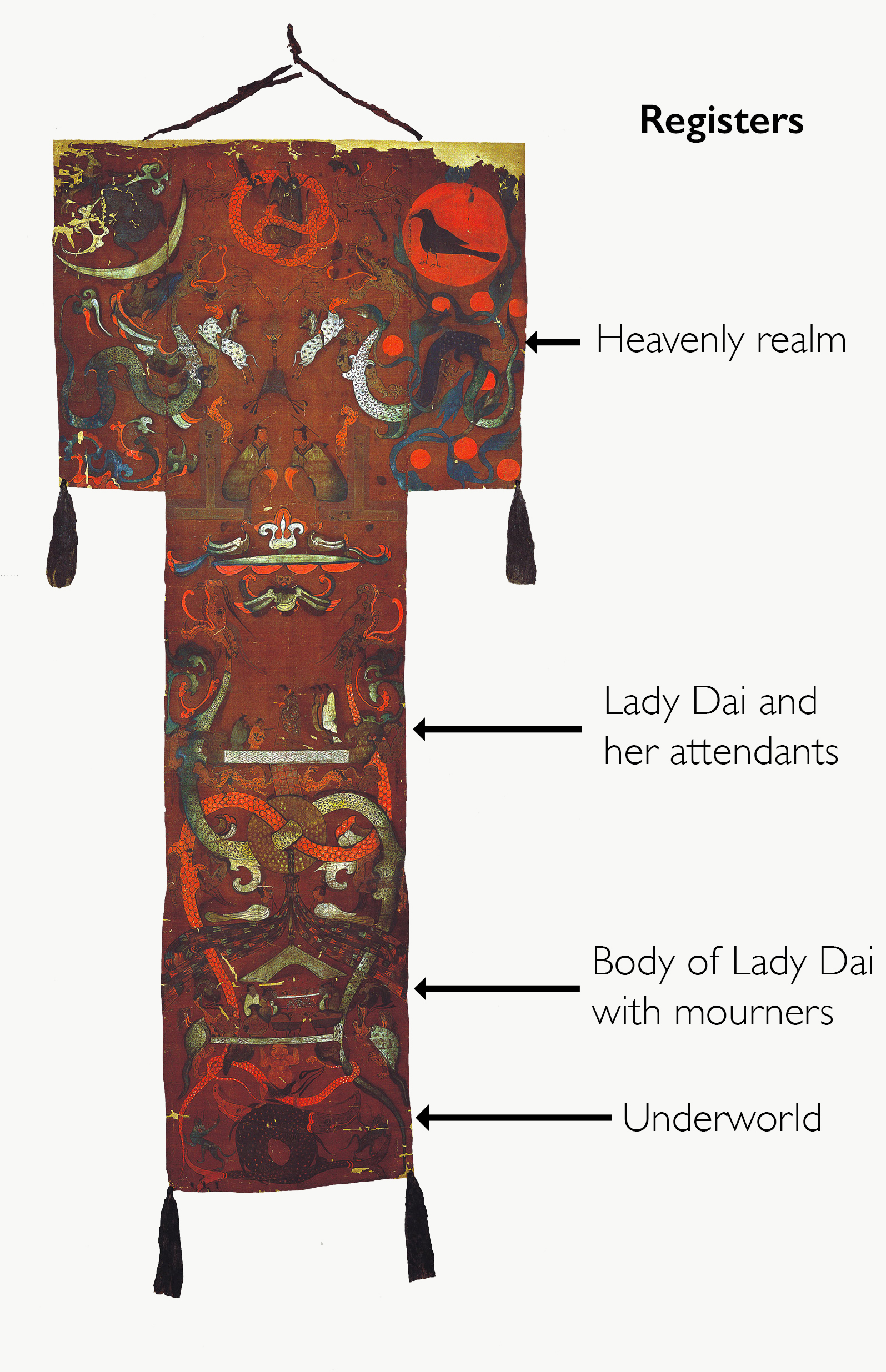
Mawangdui tomb no.1, 2nd BCE, Hunan province, China
On top of coffin was the silk “name banner”
Body of the deceased being ritualized
Top part is spiritual realm, polycentric vision of afterlife: Universe, Underworld, Immortal’s paradise
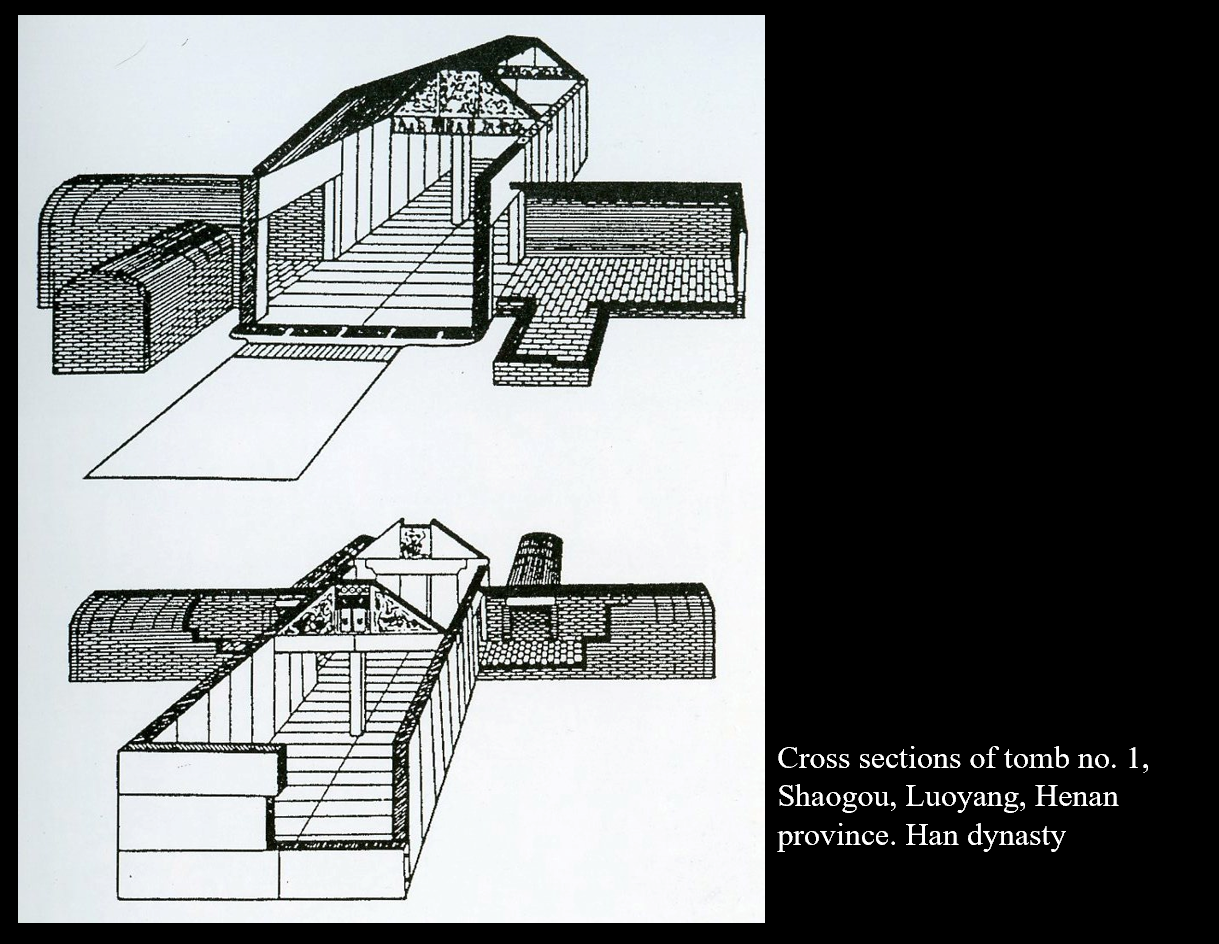
Horizontal Chamber tomb
Life sized, you could technically walk through it although legally and ritually no
Sealed underground
Innermost chamber “main chamber” is MOST IMPORTANT
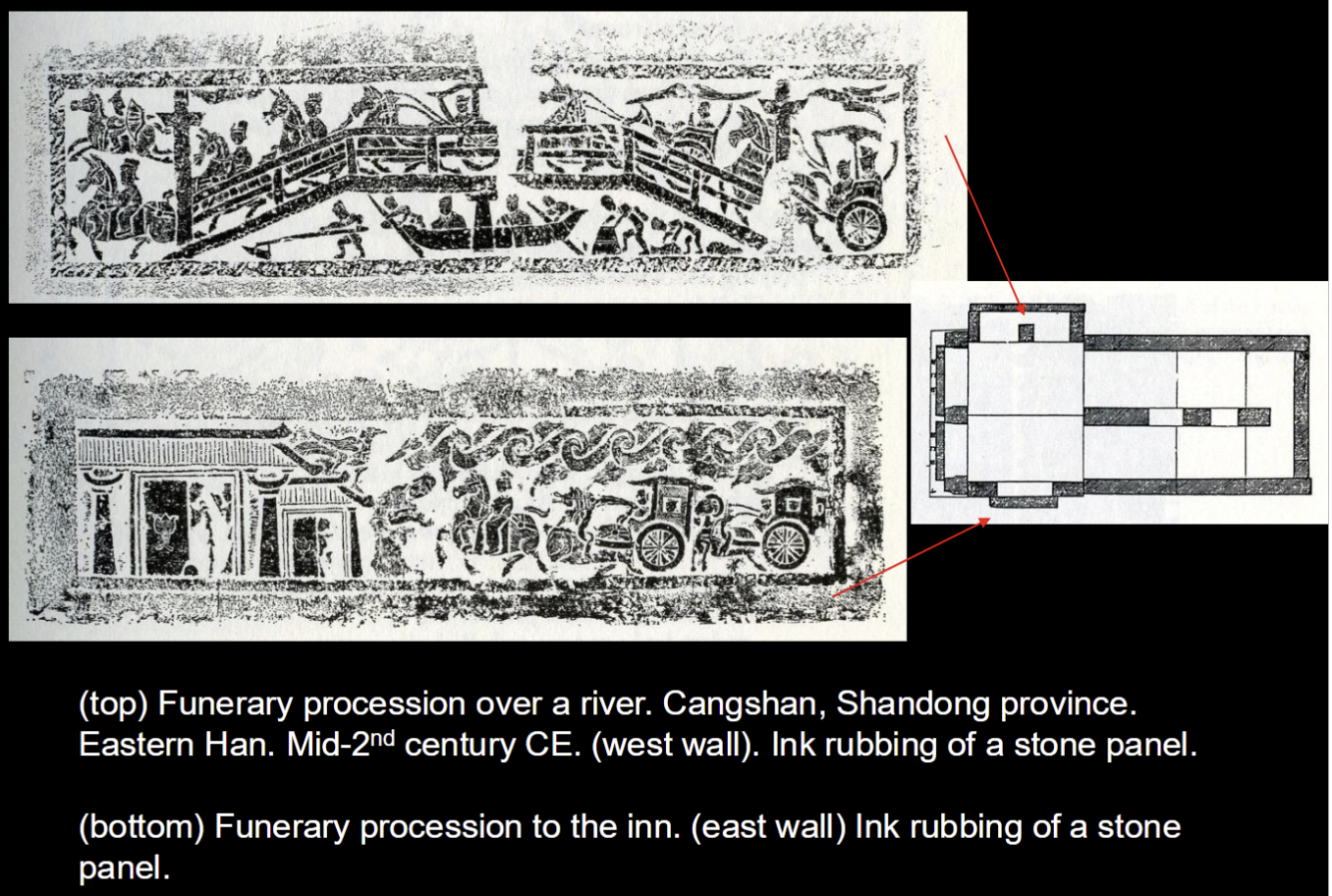
Ink rubbings
River as a symbol of crossing to other world
Open carriages for daily life, but for funerary processions it is closed carriages and driven by RAMS- or at least symbolically this animal is associated with funerals
Pay attention to large sized figures
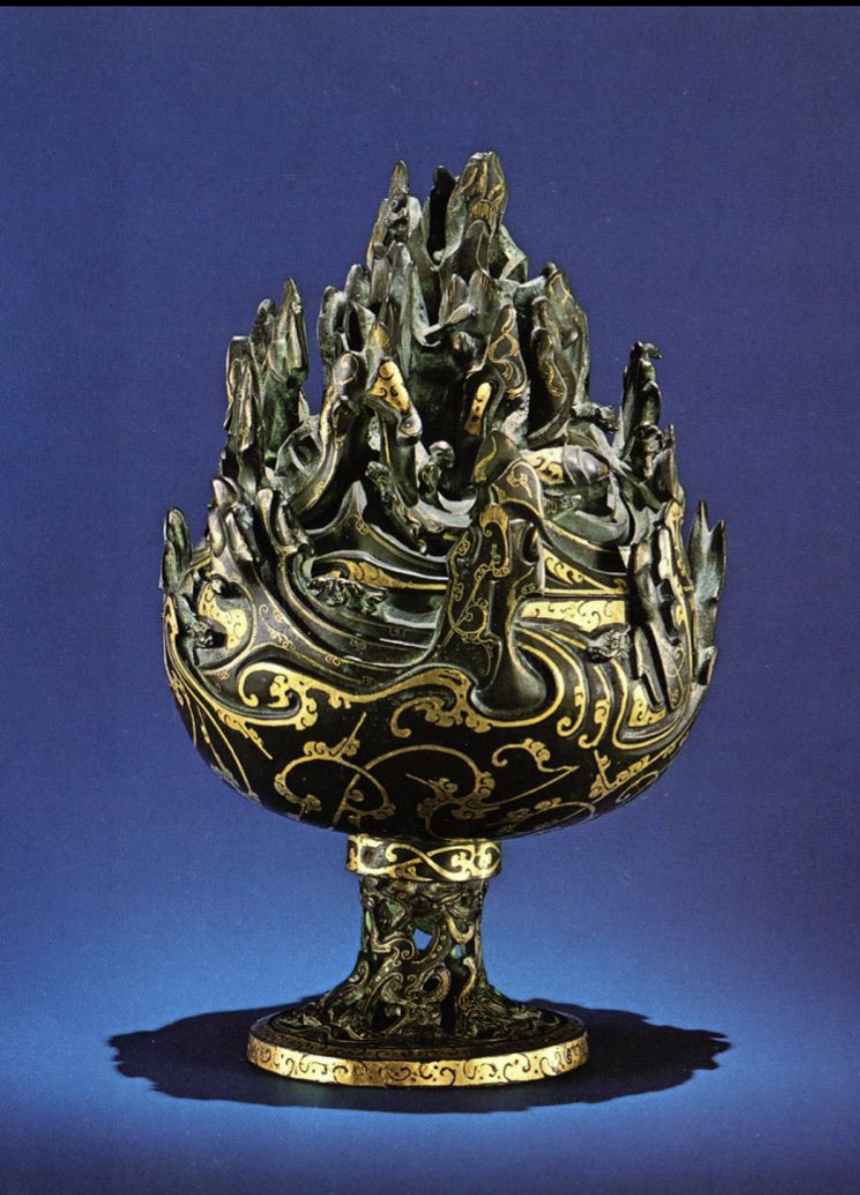
Incense burner in the shape of Mt.Kunlun found in Liu Sheng’s tomb.
113 BCE, Han dynasty. Hebei province, China
Material Symbolism of Jade
Precious and difficult material to work with
Bi-disk found in Lady Dai’s name banner, 2 dragons connect through the disk→ symbol of high class
Doesn’t degrade, concept of immortality
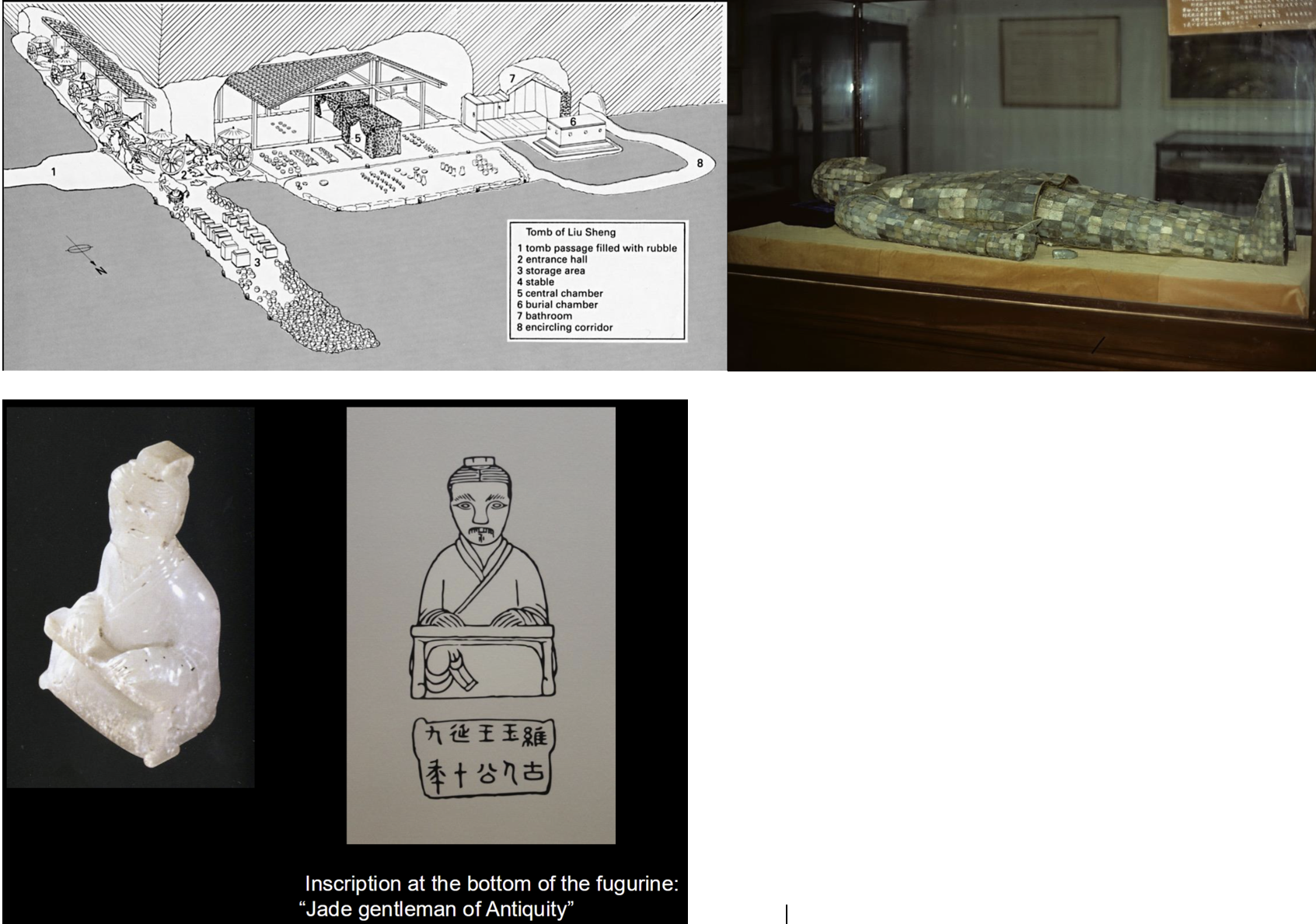
Prince Liu Sheng’s tomb: Han dynasty, 113 BCE, Mancheng, Heibei province China
Body of deceased covered in jade pieces tied together
Jade body > body will transform into the jade > immortality
jade bead/disk on the head
Reading: Jane Portal “Three Kingdoms and Unified Silla”
Three Kings Period 300-668
Silla went on to unify the majority of the Korean peninsula
Korea was at first divided into four: Koguryo, Paekche, Kaya/Karak, Silla
Koguryo:
Early Koguryo tombs were cairns, then became enormous stepped pyramids with elevated burial chambers
Later tombs show influence from Han Dynasty; white tiger and green dragon
End of 6th century includes Buddhist guardian figures, shows acceptance of Buddhism
3 thematic groups in Koguryo tombs: Illustrating events in occupant’s life, Chinese animals of the four directions, Portraying the occupant
Earthenware roof-tiles and tile ends to decorate palaces + temples is evidence of chinese influence
Paekche:
King adopted Buddhist faith
Paekche had greatest artistic refinement + sophistication
Tombs were horizontal chambers, jar coffins, stepped pyramid chamber shows contact with Koguryo
Impressive intact King Muryong chamber similar to chinese liang tombs
Evidence of high quality metalwork of bronze wine cup, decorated with lotus petals and dragons in his tomv
Lotus is buddhism, silver lid is Daoism ( afterlife; heavenly beings, immortals flying around in cloudy landscape)
also seen in incense burners
Silla:
Had great agricultural production
Shamanism continued to be practiced too as seen through gold crowns in Silla royal tombs. Adopted Buddhism later
Stone-surround wooden chamber tombs- not easily looted since wood would decay and collapse
Inclusion of foreign glass vessels suggests chinese contact
‘Heavenly horse’ motif could be linked to silk route or inlaid jades from scythia, or unicorn from han dynasty
Unified Silla:
Chambers covered in smaller mound of earth faced with upright stone slabs carved with 12 animals of zodiac, carrying weapons to guard deceased
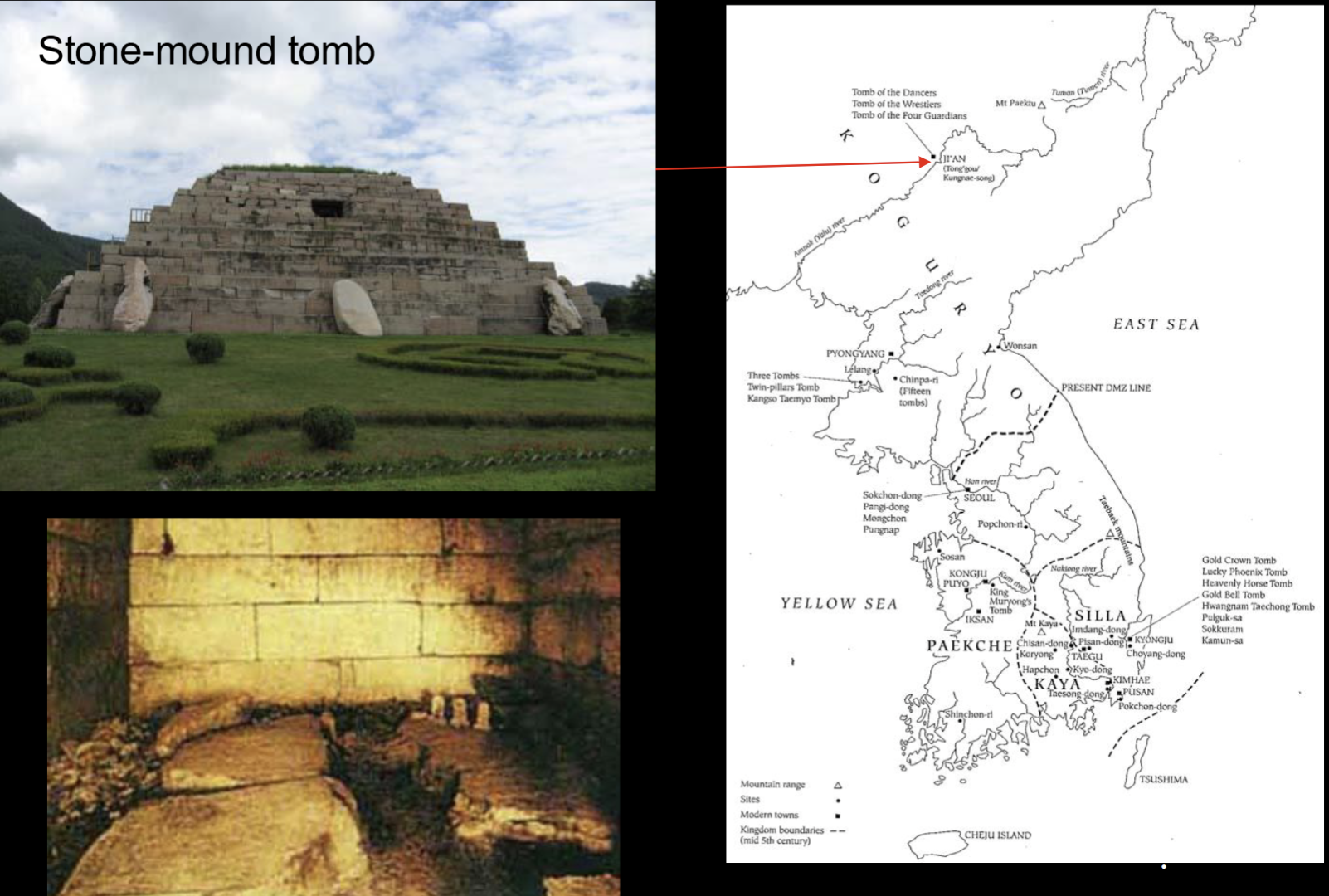
Tomb of the General. Koguryo. Ji'an. Jilin province, China. Late 4th-early 5th c.
12m high. Composed of more than 1000 stone pieces
Stone mound tomb
Ho-Sok “protecting stone”, 12 of them placed around the sides ; connect ancestors to deities, verticality tied with ritualistic beliefs.
Shamanistic belief in power of large stone
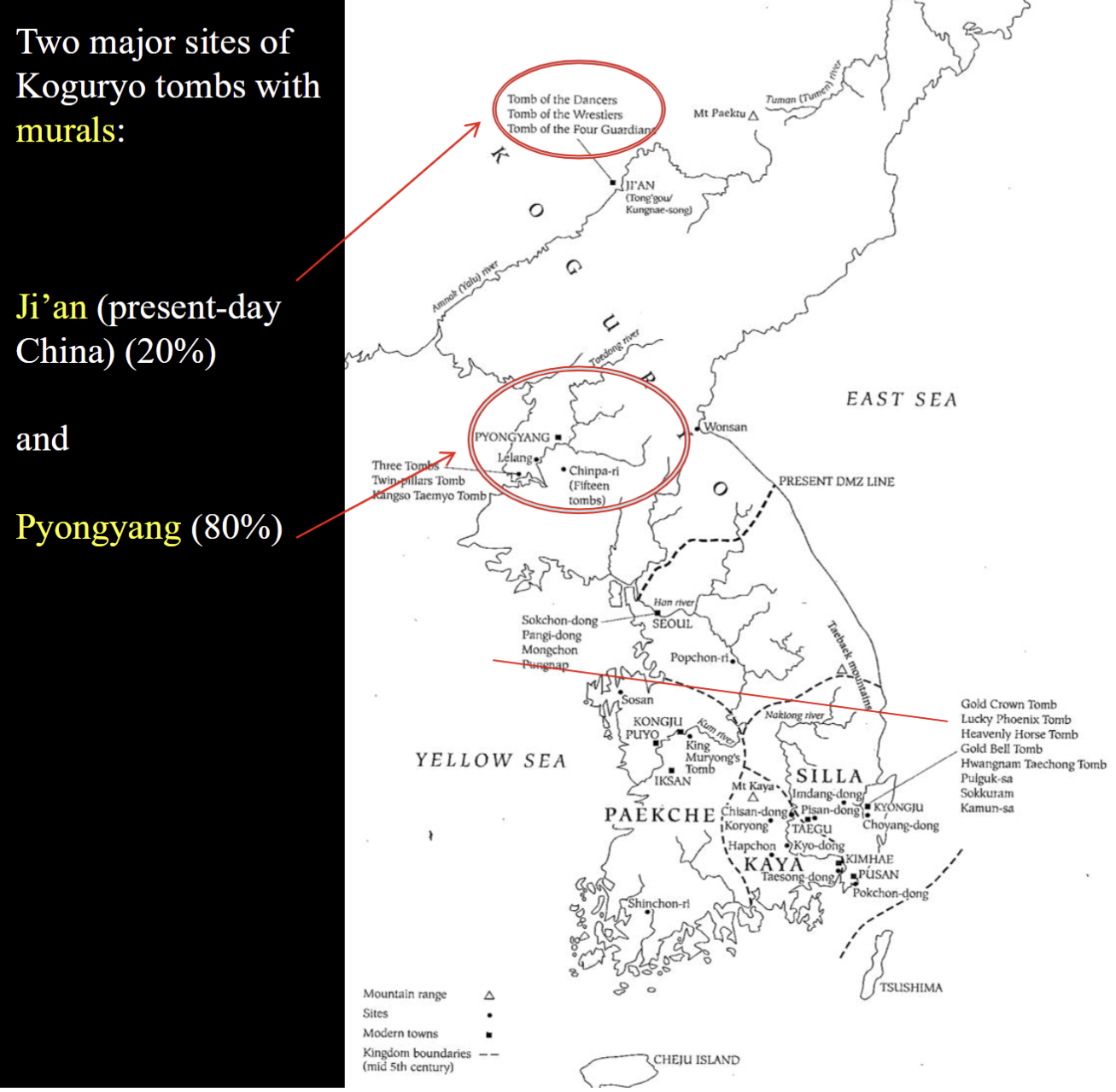
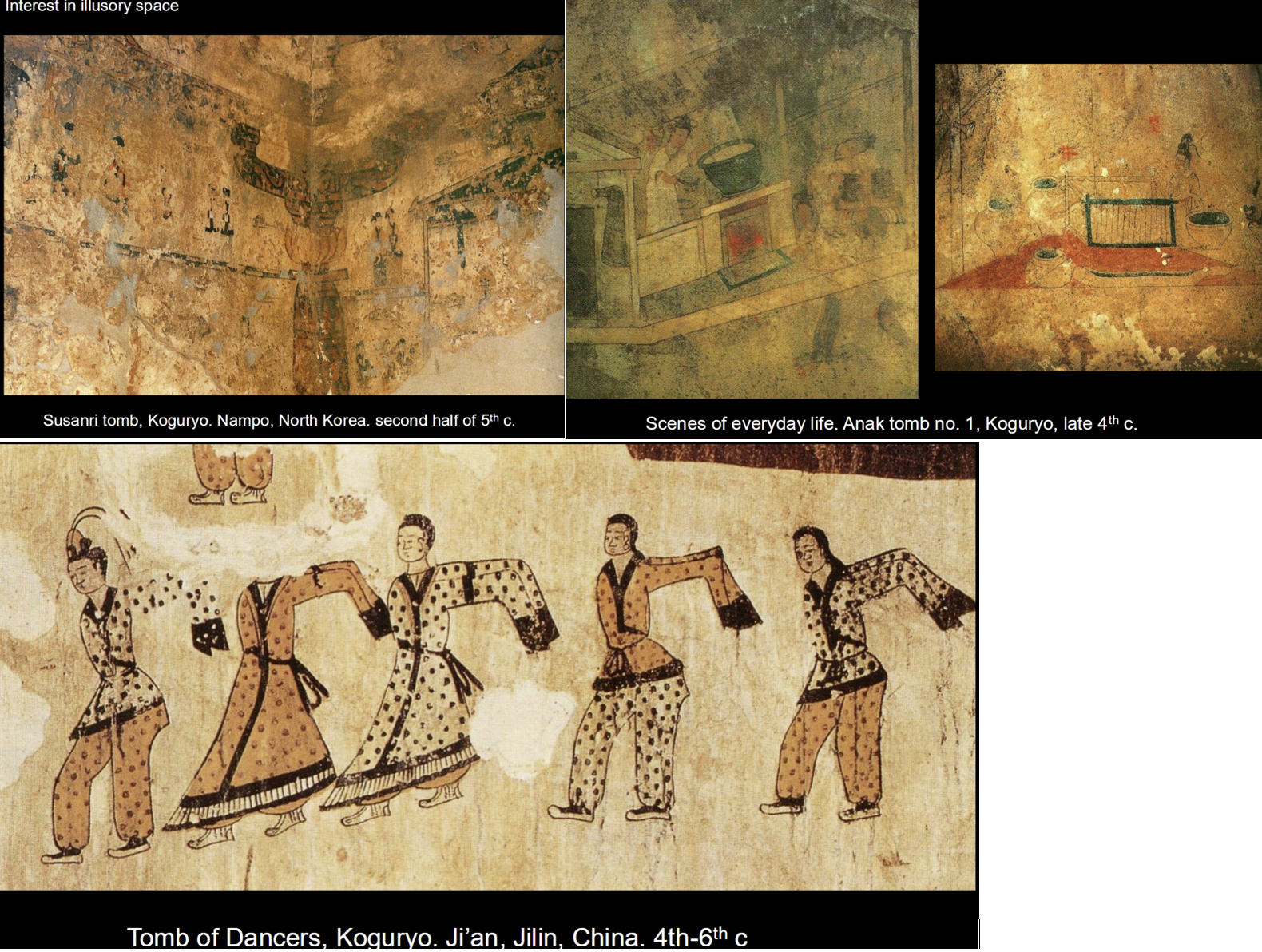
Three phases of thematic changes in koguryo tomb murals
Tomb as a home for the deceased (late 3rd to 5th century):
Food, pots
Images of banquets, dancing
Interest in illusory space, idea of domestic space painted in life-size
Major ritual function: Tokungri tomb; Chin, refugee from China
Tomb as a diversified celestial world (mid-5th to early 6th centuries):
Motifs 4 directional animals: Blue Dragon west, White Tiger East, Vermillion Phoenix South, Dark Warrior (Tortoise) North
Expression of indigenous motifs and style
Idea of creating another level of universe, walls used as small universe
Tomb space as idealized universe (mid-6th to the 7th centuries)
Great tomb of Kangso, Pyongyang, Koguryo ; mural of the 4 directional animals as celestial beings
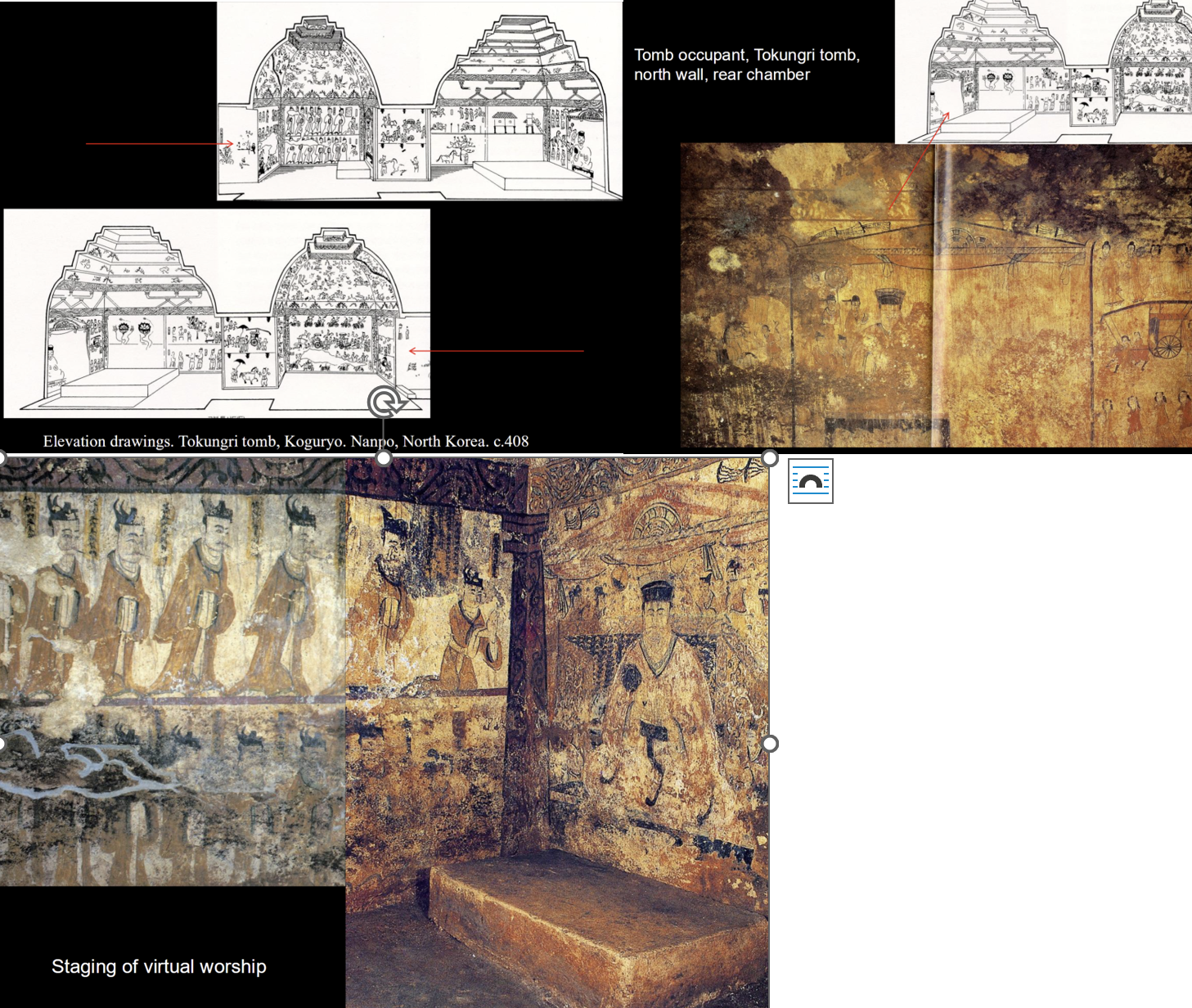
Tokungri Tomb
Idea of commemoration, leaning towards large size portrait of tomb occupant. He faces the viewer, we can guess he was focus of ritual
Main chamber: Part of wall painted with big lotus (symbol of rebirth in Buddhism)
North wall has canopy painted with man inside (occupant), empty space next to him reserved for his wife, on the right there are female servants and ox-ridden carriages usually for women
Transcultural Han Dynasty as similar servants leaning and tomb occupant portrait facing viewer.
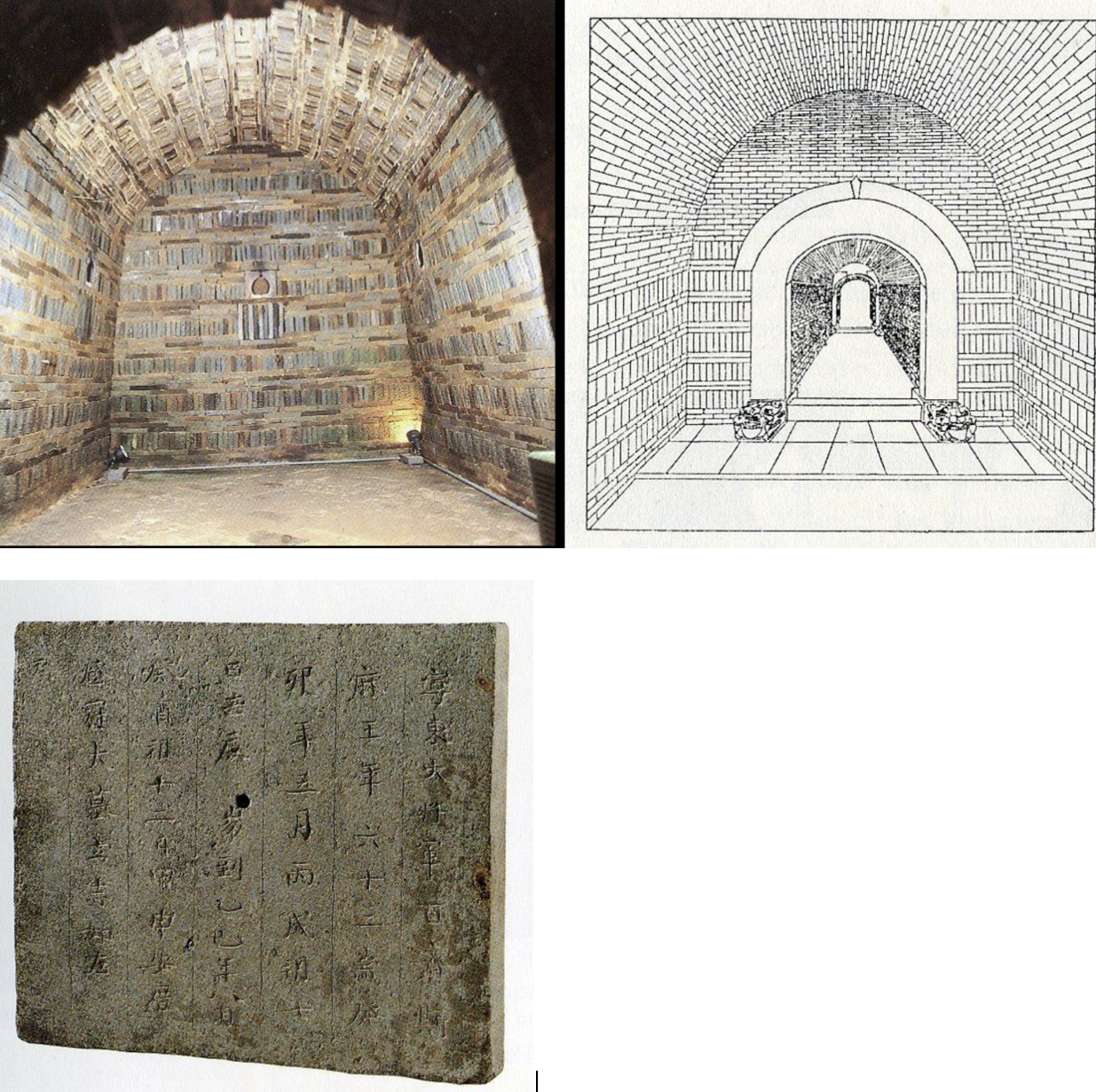
Tomb of King Muryong, Paekche, Korea. c.525 - compared to line drawing of the interior of a Liang dynasty tomb. 6th c. China.
Diplomatic connection
Artifacts: Earlier Chinese bronze mirrors and contemporaneous
Chinese ceramics. Show connectionBurial objects: Land deed: Paid to “King of the Earth”, indigenous beliefs (Daoism) of China
Daoism emphasizes the relationship between humanity and cosmos
For the living: action through non-action, naturalness
For the dead: seek immortality
Popular daoism: Folk beliefs developed during Han period, dervied from the desire for immortality, legends of immortalized deities, or immortal land
Philosophical daoism: Systematically organized during 2nd-5th centuries, became rival to Buddhism
Reading: Wu Hung “Realities of Life after Death”
Grave figurines : “Muyong”
Became regular component of tomb furnishings during middle-late Eastern Zhou period
Essential for constructing a post-humous world and substitutes of human sacrifice
Miniatures regained popularity in early Han period, with stronger effort to mimic life forms
Mawangdui tomb no.1 - Lady Dai’s tomb: Northern Chamber wooden figurines (dancers, musicians) represent social life. Southern + Eastern chamber had male figurines representing household servants and household properties.
Reading: Collcutt “The Archeological Origins of Japanese Culture and Society”
Earliest phase was paleolithic hunting and gathering
Ceramic Mesolithic phase also known as Jomon
Yayoi culture → metal work, woven clothes, agriculture
300 AD - great tombs in Yamato region ; emergence of first clearly defined political entity of Yamato Dynasty
Immigrants from Korean Peninsula, China or Northern Asia via Kuriles ; Introduced some new technologies
In middle Jomon, pottery had luxuriant forms and powerful surface decoration: Leaping flames, snake head suggest ritual and functional use
Jars also used for burial or religious offerings
Stone Phalli found
Dogu - Carved stone and clay figurines representing pregnant women may facilitate childbirth, alleviate diseases or simulate burial
Yayoi period pottery characterized by smooth lines and surfaces, burnished or sometimes with painted geometric designs
Compared to Jomon, Yayoi made social rank more obvious: Chieftains and their families were buried in rectangular mounds w shaft graves in them
Grave goods included bronze mirror, semi-precious beads, weapons
Bronze + Iron ages simultaneously : Iron was utalitarian and Bronze was for ritual and power show
Bronze bells “Dotaku” ritual symbol and politcal authority
Kofun period- more tombs built
expressions of power
Key-hole shaped in side of existing hill
Haniwa- Rings of clay figurines set on kofun substitute live burials, laid out in ritual order
Evidence of horse riding culture
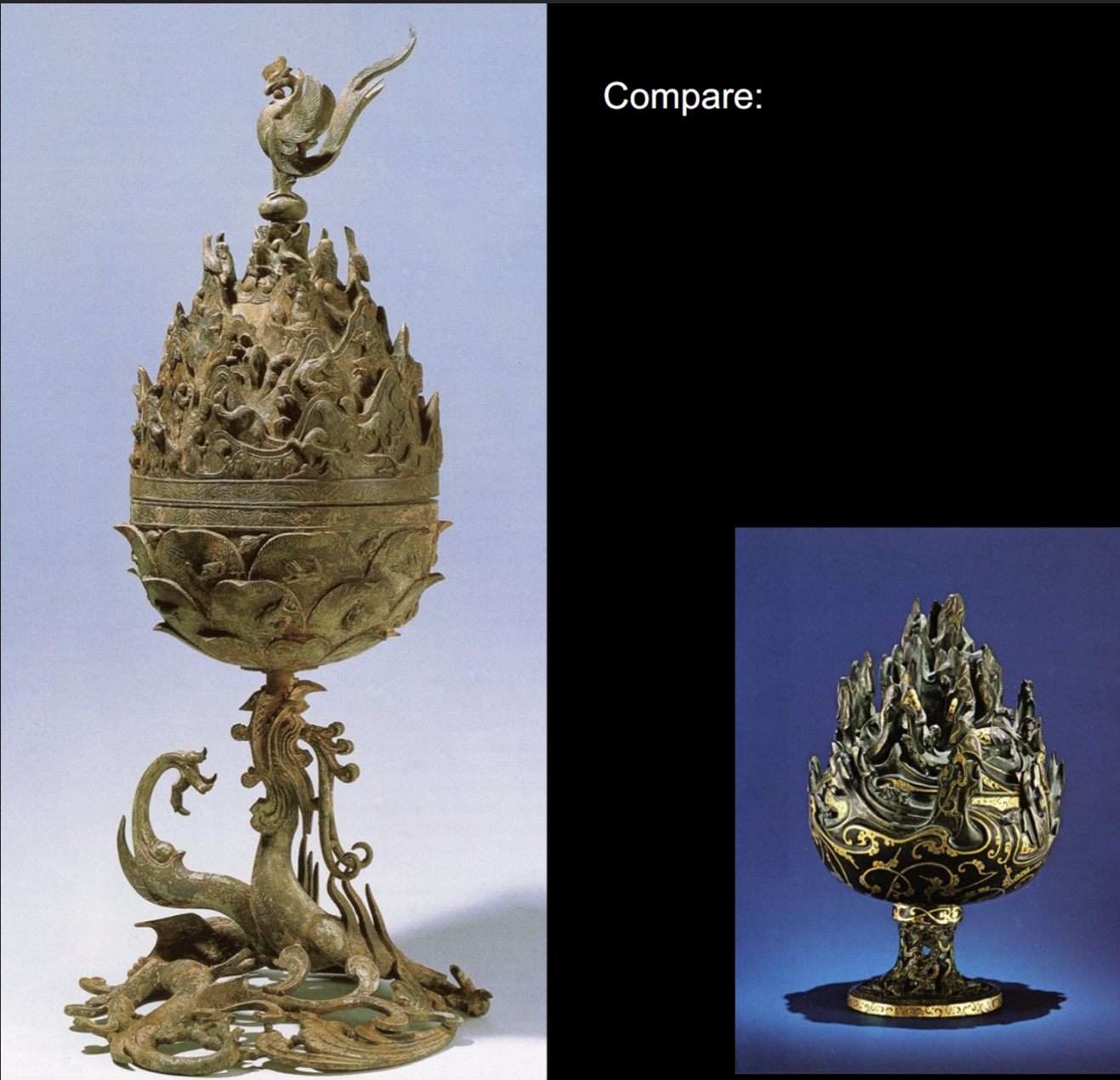
Pongnaesan (Mt. Pongnae) incense burner, Gilt bronze, Paekche, early 7th cent
→ compared with Incense burner Mt.Kunlun found in Liu Sheng’s tomb, Han dynasty
Believed to be residence of immortals
Idea formed in popular Daoism
Fluid naturalistic form of mountain
Idea of exploring; phoenix on top
Bottom of mountain is different, looks like a lotus flower
Amalgamation of Daoist and Buddhist ideas; top daoism, bottom buddhist
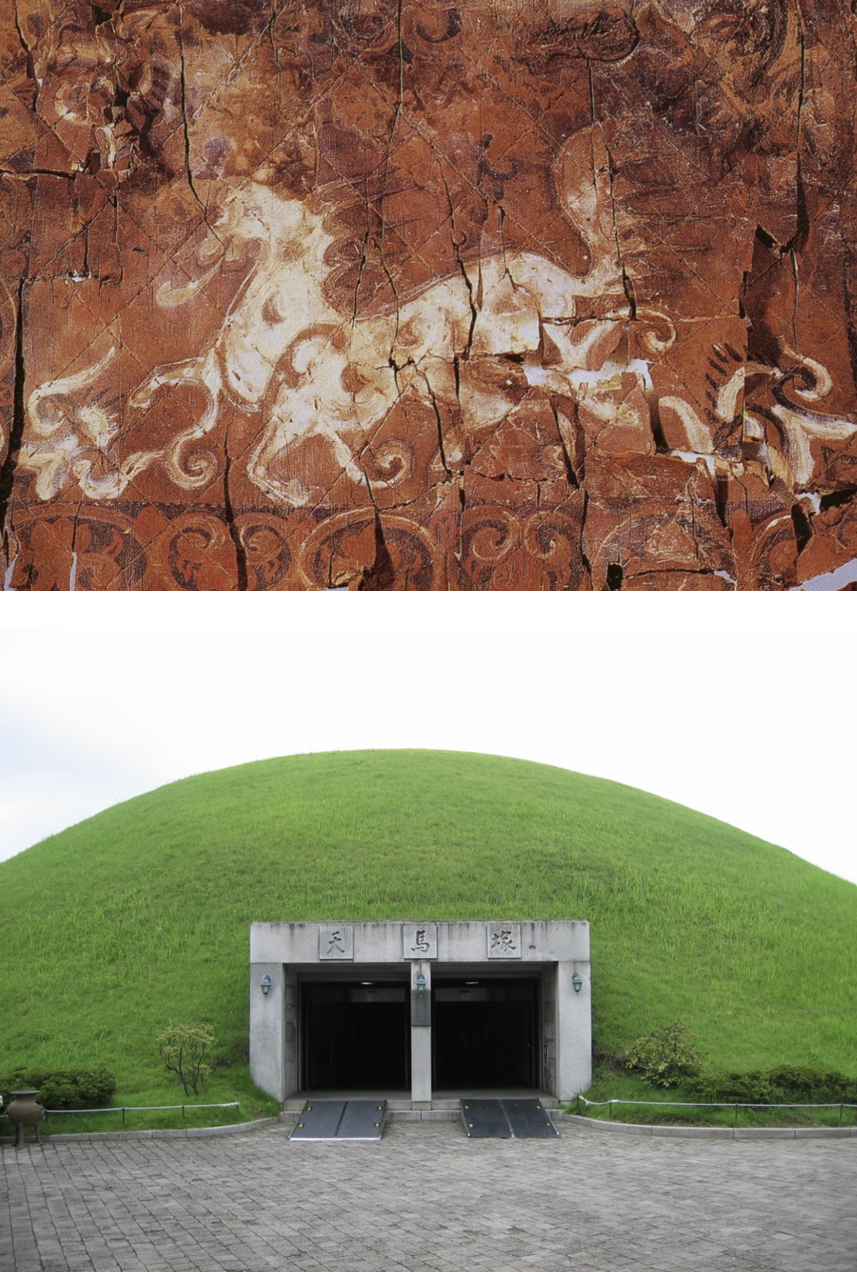
Tomb of Heavenly Horse, 5-6th cent, Silla
Representation of winged horse
Indigenous motif?
Legend of founding father of Silla: guy born out of a huge egg from this white-winged horse
Transcultural connection: Similar flying horse imagery in China, West Asia has similar patterns seen under the horse Palmette patterns originate from Egypt
Gold crown
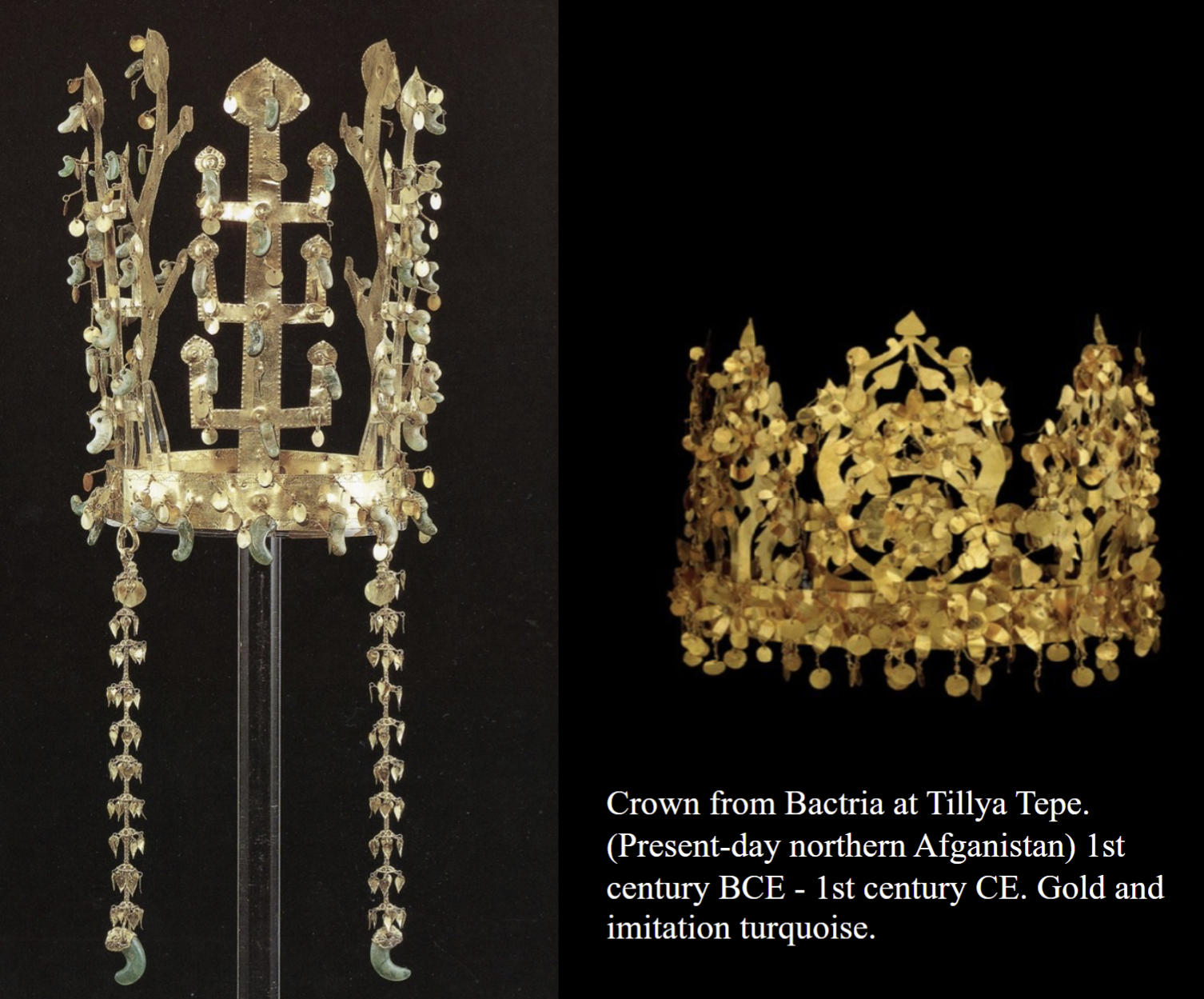
Royal crown from Tomb of Gold Crown. Silla. 5th -6th ce
Further connection to West Asia
Gold is paper thin (hard skills required for that)
Form similar to animal horns
Jade pieces dangling from crown
Connection to west asia: Bactria (now afghanistan) with paper thin quality
Silk route
Gold object: Belt with pendants also found in Great Tomb of Hwangnam, looks like belt worn by Princes in China
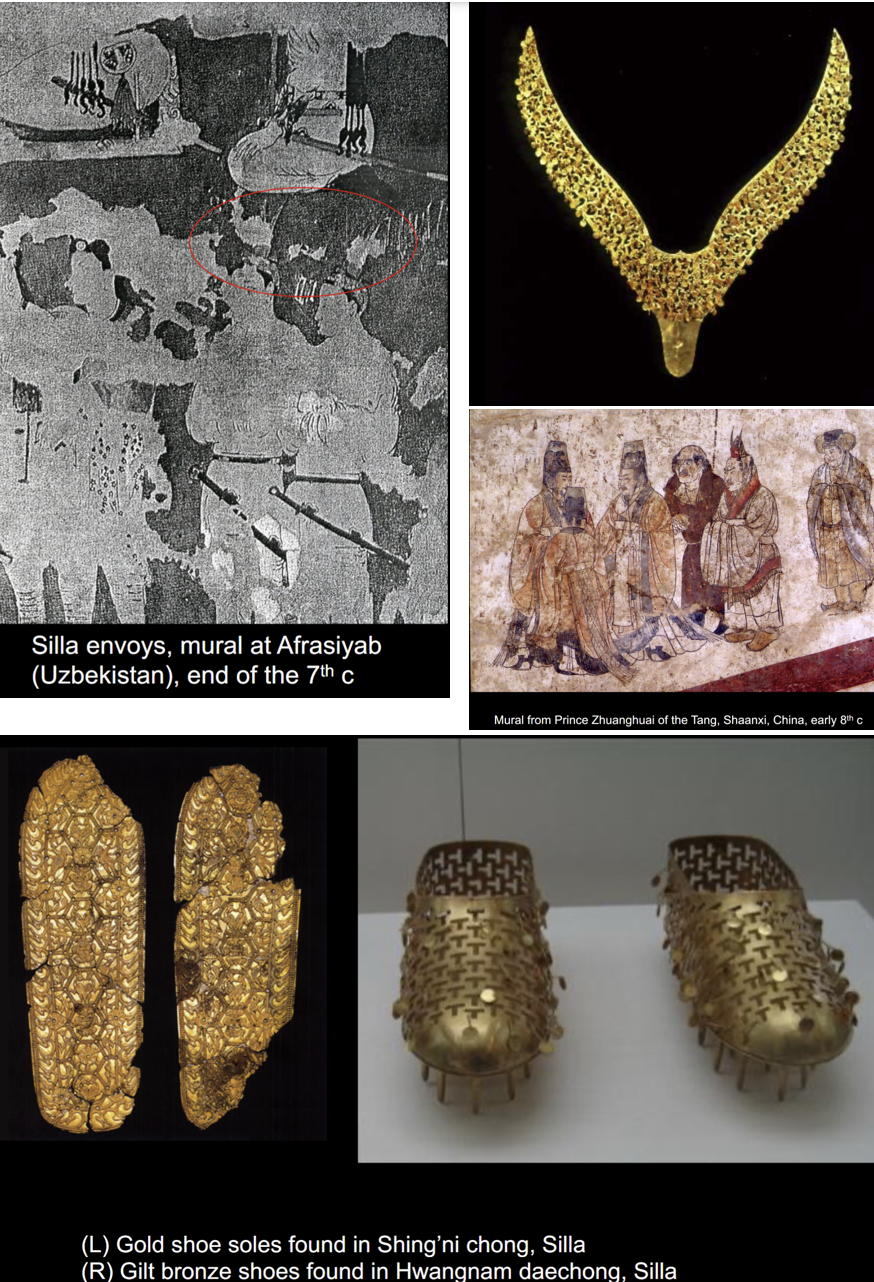
Trade between China and West Asia
Began as early as Han Dynasty
Mainly through Silk Roads used by Buddhist monks and merchants
By the end of Unified Silla (7-8th cent) there was direct trade between Silla Courts and Islamic merchants, Silla was known to some islamic countries as land of gold
Other examples:
Gold shoes used for burials
Wing-shaped ornament and hat in same tomb as heavenly horse; used for diplomatic activities, feathers found in tomb associate with high class burials; birds as metaphor for the soul flying away
Key periods of Prehistoric Japan
Jomon (ceramic) 10,000 - 300 BCE
Yayoi (metals) 300 BCE- 300 CE
Kofun (tombs, first political entity) 300 - 700 CE
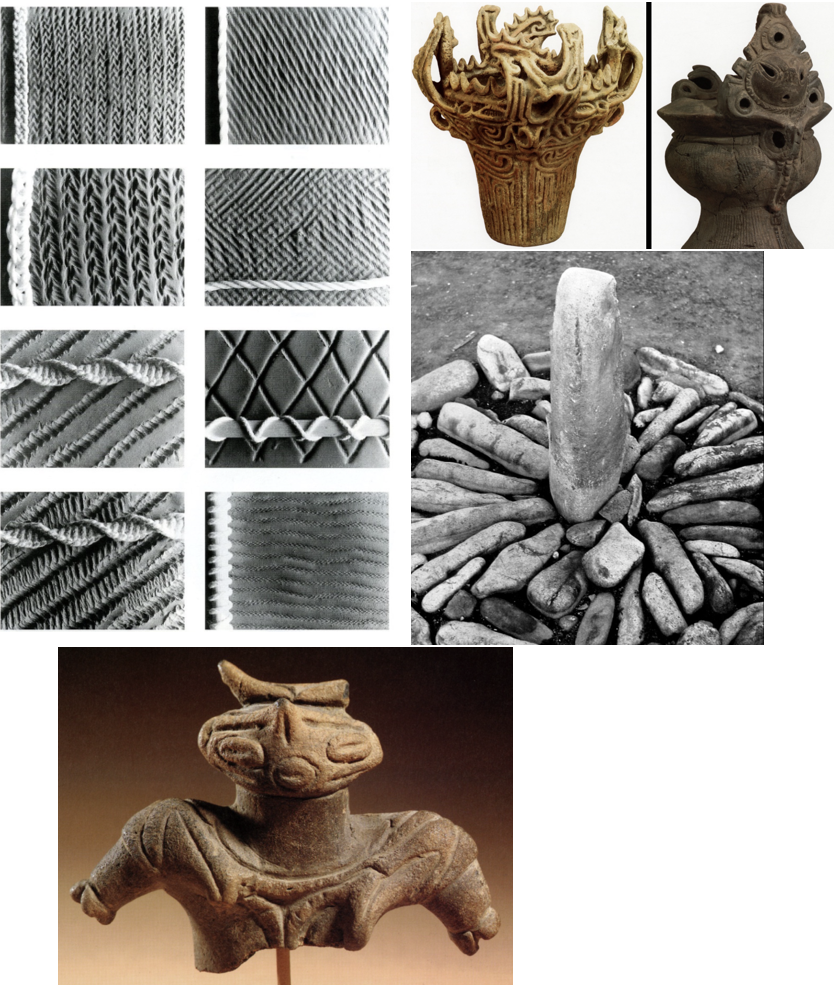
Jomon Period 10 000 - 300 BCE
“Rope Cord pattern”
Technique of coiling and firing pottery
“Dogu” figurines consistently found broken, encouraging reproduction, ritual purpose
Stone circle with phallic symbol. Both of these are possibly shintai
Primordial form of shinto- “Way of the Gods” with “way” being the chinese concept Dao, which is an important concept in Daoism and Confucianism
Basic concepts:
KAMI “divine presence / force): Important deities and figures.
Heavenly deities of national significance
Earthly deities ; mountain kami, river kami
Revered peope; Uji - clan system
Common Kami; rock, trees, water
SHINTAI: embodiment of Kami
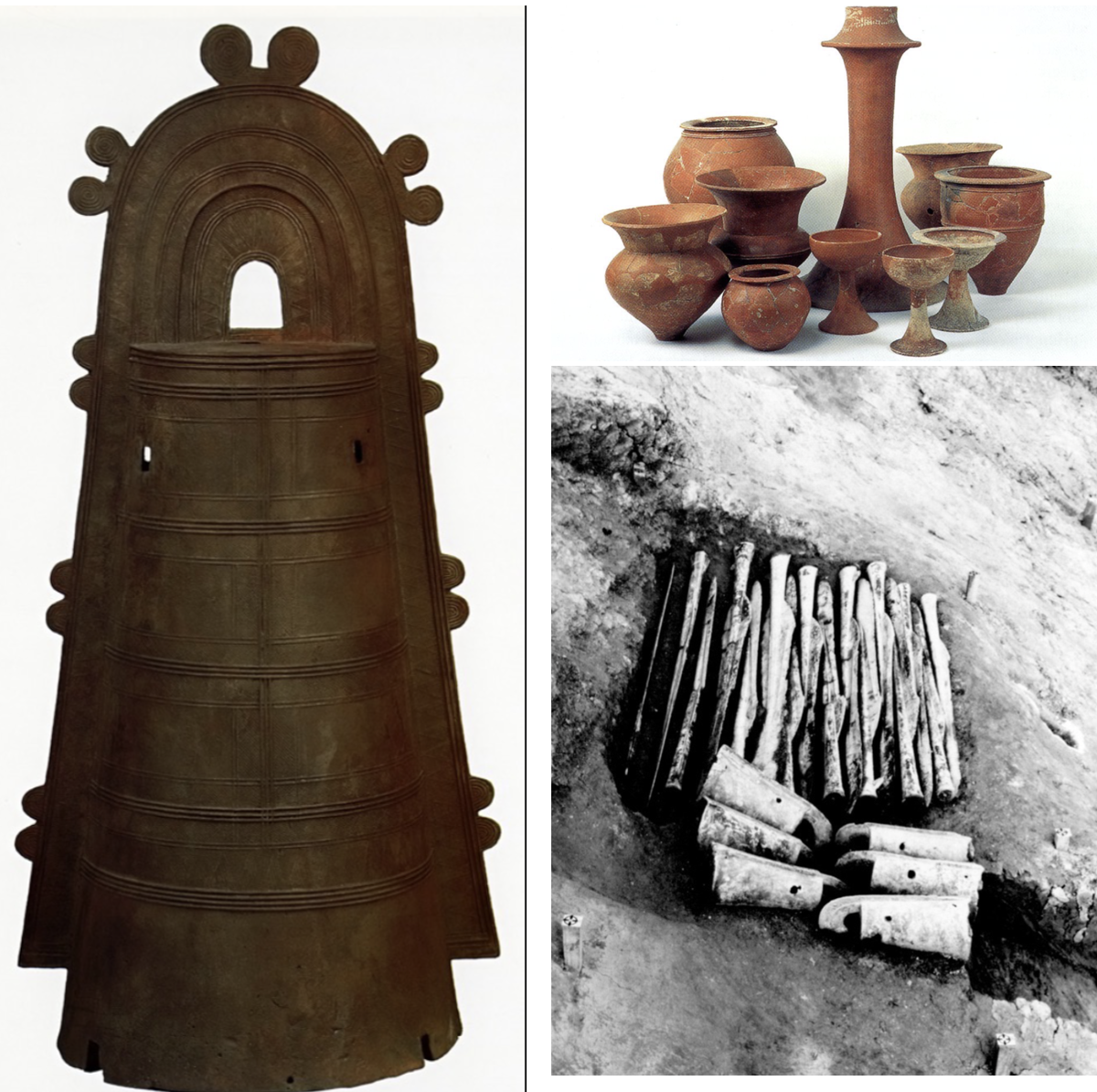
Yayoi period
Images:
Bronze bell (“Dotaku”).
Weapon and bronze bell burial
Vessels. Middle Yayoi Period, c. 100 BCE-100CE. Painted earthenware. 53 cm.
Social hierarchies to distribute labour - top is Uji clan
Continuous need for fertility of the land- birth of field deity and others
Need for dealing with the dead
Emergence of ruling class
Emergence of priests, shamans to manage relations with spirits and deities
Yayoi vessels are much more symmetrical and less flamboyant silhouettes compared to Jomon
Function as ritual objectives since they’re too fragile to be used
Earlier bronze bells from China → Yayoi bronze bell → longer and thinner so probs for rituals
Some bells have inscriptions and drawings of shamans performing rituals
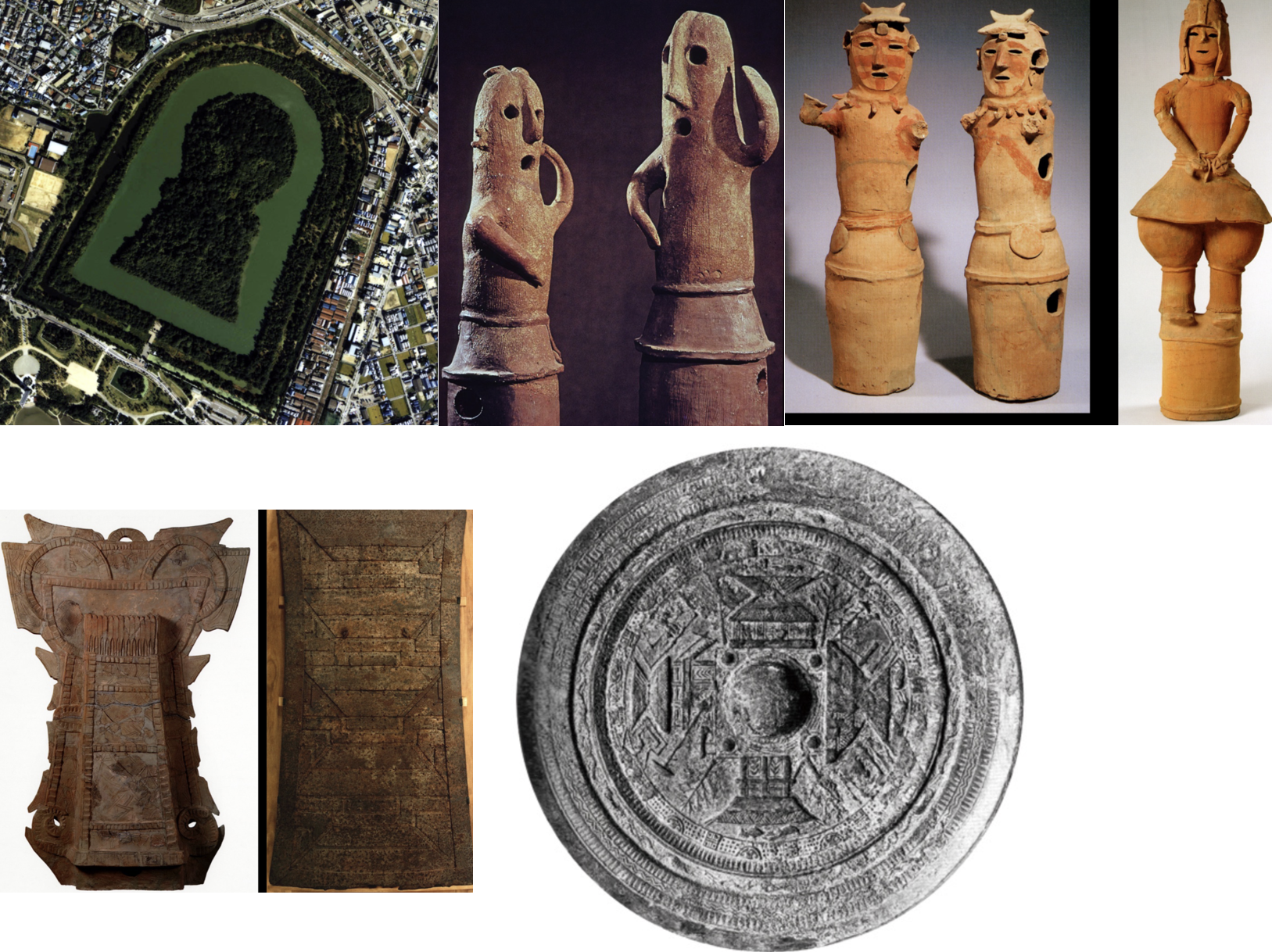
Kofun period “Ancient tombs” 300-700 CE
Emperor Nintoku’s Kofun : moats and mounds, stone horizontal chambers, furnished with coffins and grave goods. Round was heaven, square was earth
Haniwa figurines: Dancers, soldiers, shamans, shields → compared with Mingqi. Placed around keyhole shape. Earthen ware providing protection and companionship
Bronze mirrors with Architectural designs in the back. “Chokomon” pattern of straight lines and arcs.
Geometric similarity with Chinese bronze mirrors
Symbolic value
Mirror is one of the imperial regalia (mirror, jewel, sword) , political symbolism of chocomon mirrors as they would be seen on objects for Yamato clan and government higher ups. (coffins, shields)
Tomb Murals
War paintings
Takehara tomb mural made in late Kofun period. → compared with Tokungri tomb in Koguryo of “Groom with a Horse”
Water like elements of crossing the river to other realm /afterlife
Further Intercultural connection between Japan and Kore
Japan and Kaya federation horse; clay material, tube-like form, kaya predates Kofun
Kofun shaman figurine necklace has curved bead like Silla jade beads seen on crown
Gold earrings from Silla and Kaya also in Kofun period
Takamatsu tomb (late 7th- early 8th cent). 4 directional animals compared with Koguryo tombs, courtly ladies in Koguryo dress style
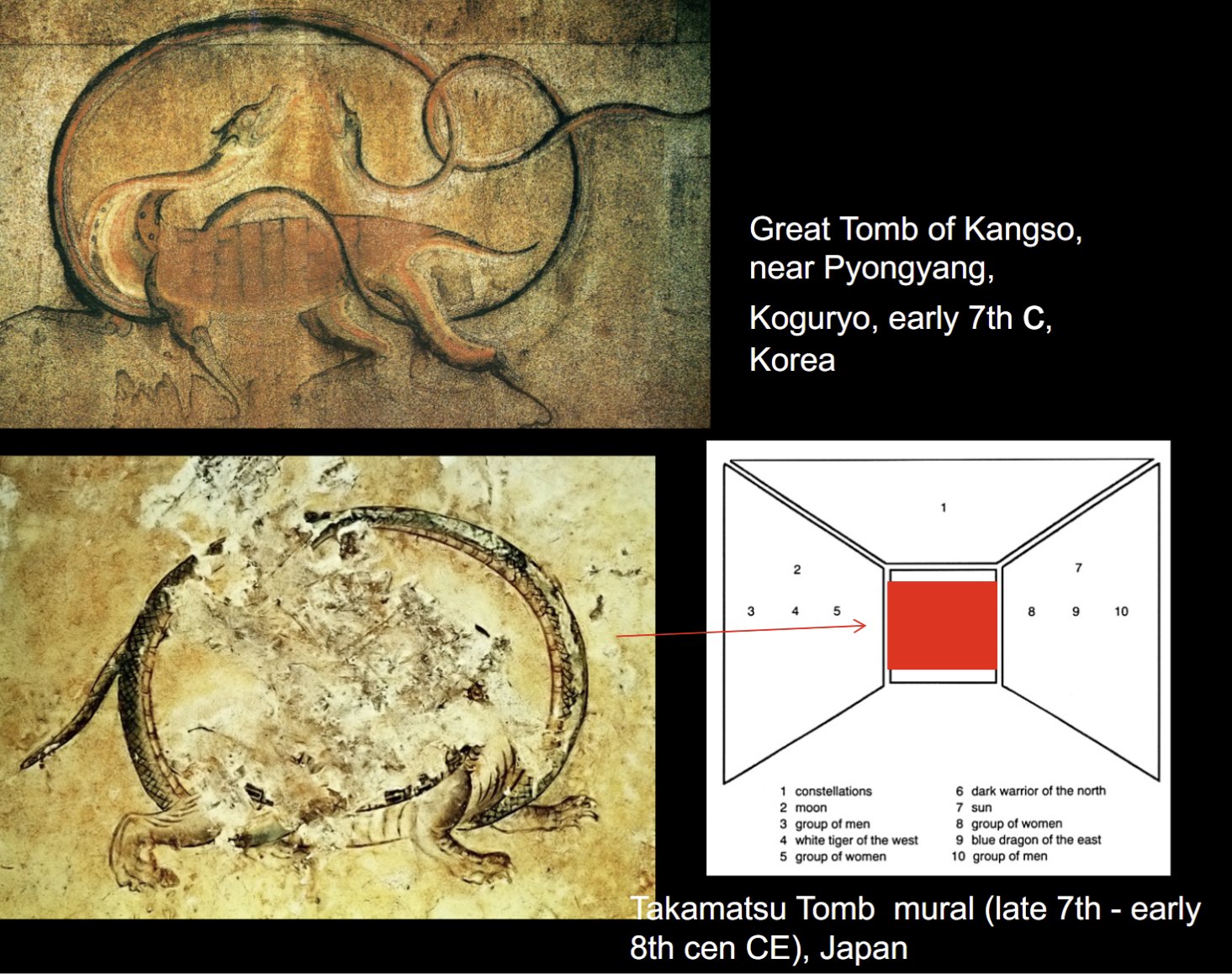
Reading: Lopez, “Buddhism in Practice”
Buddhist community flourished in India during Mauryan Dynasty (324-187 BCE)
Mahayana “Great Vehicle” as a social movement of monks, nuns, and lay people that began in reaction against powerful monastic institution
Hinayana “Lesser Vehicle”
Pan-Asian religion through material movement of monks, texts, relics and icons along trade routes
Buddhist institutions tended to be stronger in China when the central government was weakest
Contact with China brought Buddhist monks into the Korean Peninsula in late 4th century. → brought with them products of Chinese civilization
Part of the appeal of Buddhism to Kings was the claim that worshipping the Buddha, promoting the dharma and supporting the monastic community would protect the state from foreign invasion and calamity.
Buddhist worldview suggests that sentient beings need protection from suffering of “Samsara”, the cycle of rebirths
View of universe and afterlife;
Realm of desire- inhabited by humans, 4 islands surrounding one mountain where Buddha achieved enlightment
Realm of form- Superior to realm of desire. Inhabited by gods but they can’t taste or smell → greater concentration and mental bliss
Formless realm- Gods exist in states of pure conciousness without bodies and sense organs
Karma determines quality of life and place of rebirth
Buddha’s 4 noble truths:
Life is inherently unsatisfactory, lack of control over future events
Cause of this suffering is karma
Truth of cessation, the postulation of a state beyond suffering→ if ignorance is destroyed, cease suffering and reach nirvana
Path/Technique to end ignorance; Eightfold Path
Buddha was worshipped with paintings, statues and promoted sutras
Icons were treated as spiritual beings possessing magical powers, to be worshipped with regular offerings of incense, flowers, food, money, etc.
Theravada Buddhism
Based on core teachings “Dharma” of Buddha
Born in present day Nepal as a Prince (5th-6th BCE)
Important motifs of his life: Left palace to seek truth, reached enlightment through meditation, taught disciples
Death of the Buddha “Nirvana”, escapes the wheel of birth and death
“Ancient Teachings” - Hinayana, Therava Buddhism
Monasticism
Architecture: Monasteries, pilgrimage sites centered on Stupa
Symbolic structure of Stupa: Circular form, walk clockwise ritualistically
Life of Buddha Sakkyamuni engraved in the walls
Sanchi North Gate: Attack of Mara, challenge Buddha during meditation to stop his reaching of enlightment
Image of Stupa = Death of Buddha
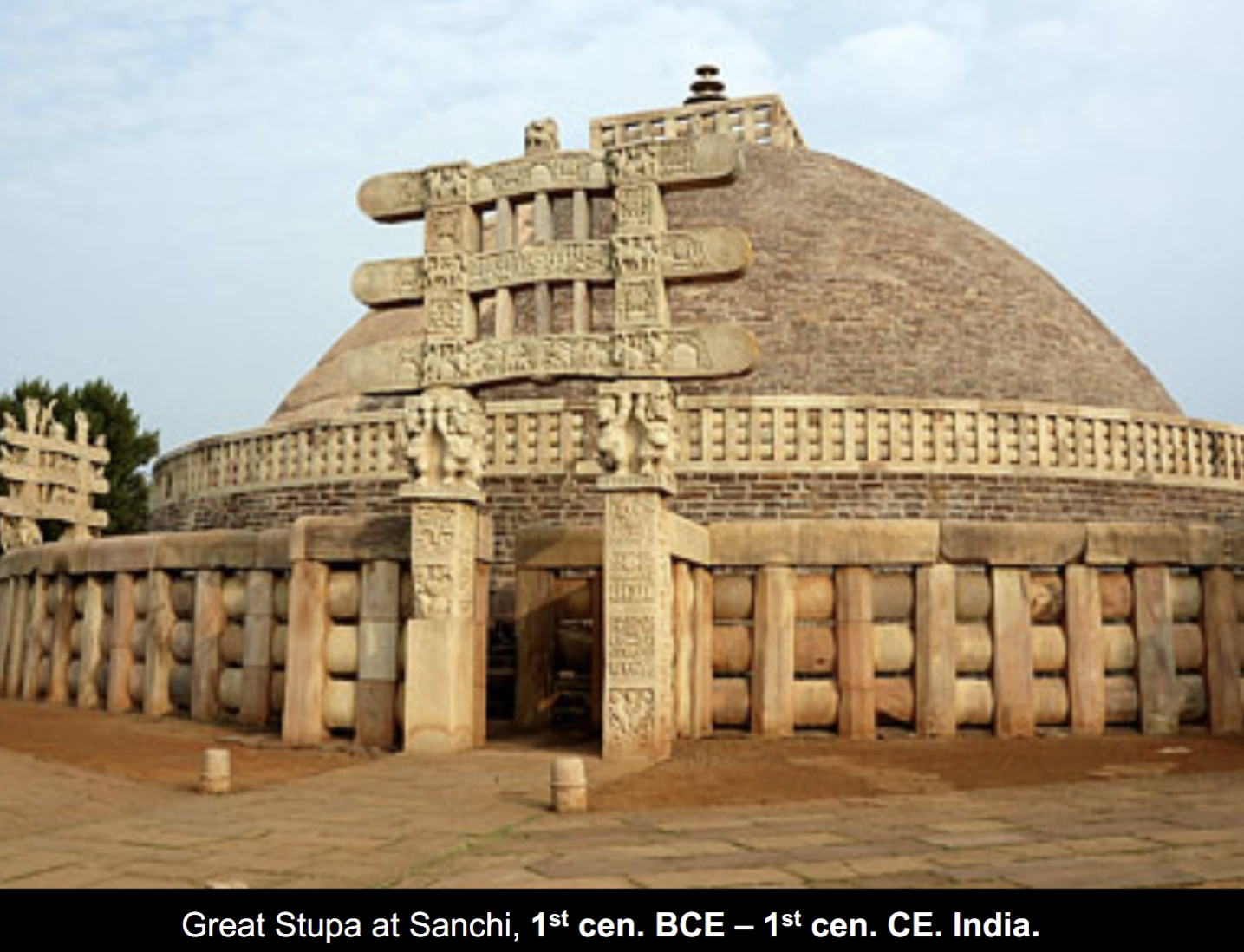
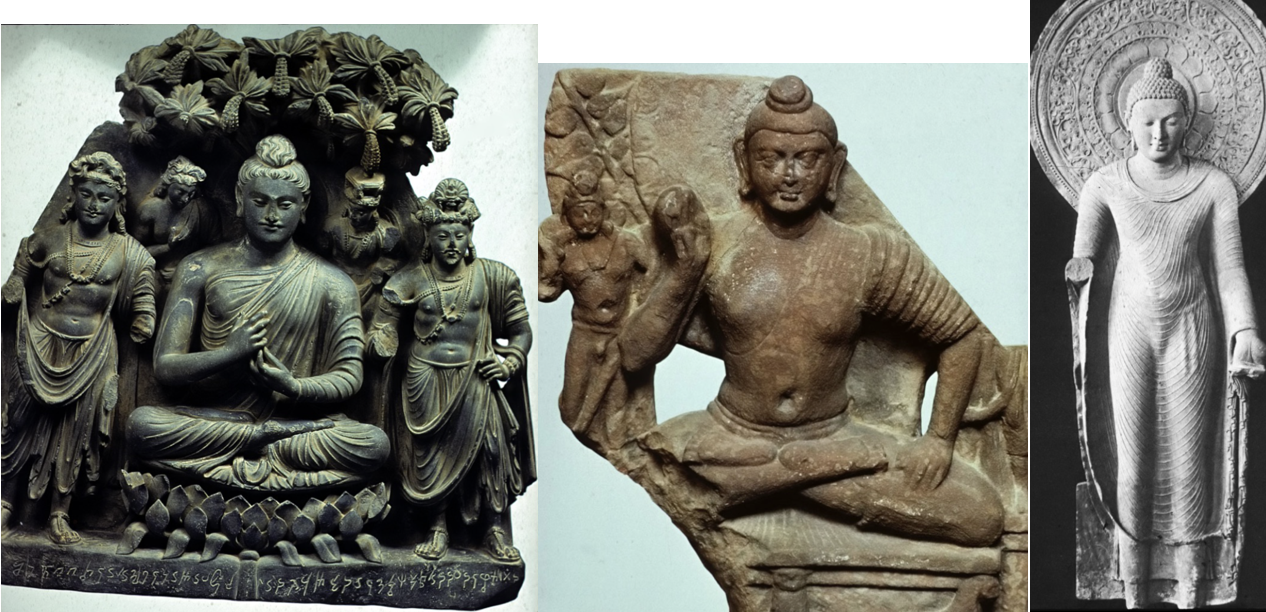
Mahayana Buddhism
Premised on Buddha’s teachings that all sentient life possesses the ‘Buddha Nature’, present in entire cosmos and time
Rapid expansion of Buddhist scriptures (sutras) to account for Mahayana cosmologies and doctrines of salvation
Monasticism heavily relies on donors, incentive of merit towards best afterlife
Art retains some focus on historical Buddha but emphasizes a wider variety of subject matter to accommodate Mahayana pantheon of deities, multiplicity of Buddha
Gandharan style in pakistan→ naturalistic body form, masculine forms
Mathura style → seated budda, not naturalistic, simple, clean lines
Gupta dynasty style→ more feminized body